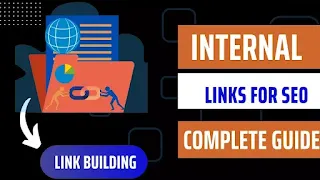What Are Internal Links?
If you are a blogger, then you must have heard about your "internal links". There are many Mahatevpuran for this website. These links are those that connect the posts of the website with each other. Internal linking is used to add a post link to another post.
For example- You wrote a post like "How to get Google Adsense approval" and another post like "What is Google Adsense". The link of one post to another post is called an add-to-use internal link.
Internal links can be useful for several reasons:
- Navigation: If you Create Internal links in your post then it will help your users to navigate the website and find the exact article that they are searching for.
- Crawling and indexing: Internal links are very helpful to fast index your post in google and help to search engines crawl and index the pages of your website, which can improve the visibility of the website in search results. If Your website is on blogger then we face indexing issues. If we do internal links then our posts crawl fast by google robots.
- Relevance and authority: if you do Internal links it can help to establish the relevance and authority of the page. internal links increase the viewer's time spend on our website and maintain the bounce rate.
- User experience: If You Make Internal links It can improve the user experience by providing users with additional resources and information related to the topic they are interested in.
By using internal links effectively, you can help improve the navigation and relevance of your website, as well as enhance the user experience.
Importance of Internal Links for SEO?
Internal linking is a technique of linking pages within a website to help users and search engines navigate between different pages. The following are some important features of internal linking:
- Anchor text: Internal links use anchor text to describe the content of the linked page. Anchor text should be relevant to the linked page and give a clear indication of what the user can expect to find on the linked page.
- Link placement: The placement of internal links on a page is important. Links placed in the body of the content are more effective than those placed in the footer or sidebar.
- Page Hierarchy: The way the pages are related to each other should reflect the hierarchy of the website. Important pages should be linked to more often and in more prominent places on the website.
- A number of links: Don't put too many internal links in a post it can be overwhelming for users and this lead to a poor user experience. so make a limited amount of internal links in a single post and make relevant internal links.
- Broken Links: Broken internal links can negatively affect the user experience and SEO of a website. Website owners should regularly check for broken links and fix them immediately.
Effective internal linking requires careful planning and execution to ensure that users can easily navigate a website and that search engines can effectively crawl and index its pages.
How To Create Internal Links In The Blog?
To create internal links in a blog post or webpage, follow these steps:
- Decide on the pages or posts you want to link to Select the pages or posts you want to link to in your blog post. These pages and posts should be related to the topic of your blog post.
- Choose relevant anchor text: Now, choose relevant anchor text for the internal link. Anchor text is very important for the value of your internal links and SEO. So choose the anchor text carefully.
- Highlight Anchor Text: Highlight the anchor text where you want to add internal links to the content of your blog post. To highlight the anchor text, select the text and choose the Link option.
- Add Link: Add the internal link URL by clicking on the selected anchor text. Save the link after adding the URL.
- Check the link: After adding the internal link, check to create Internal Link Url Working Or Not. Don't forget to check.
What Are The Benefits Of Internal Linking In A Blog?
There are several benefits of using internal linking in a blog:
- Better Navigation: Internal linking helps your visitors easily navigate to different pages of the website. It also informs your visitors about relevant content and prompts them to spend more time on your website.
- Better User Experience: With internal linking, you can motivate your visitors to spend more time on your website. Providing visitors with relevant content improves their experience on your website.
- Increased Pageviews: With internal linking, you can keep your visitors on your website for longer and send them to other posts through internal links. This also increases the overall pageviews of your website.
- Decreased Bounce Rate: Internal linking helps in navigating your visitors to different pages of your website, thereby reducing the bounce rate of your website.
Apart from all these benefits, internal linking also improves the overall structure and organization of your website. Therefore, internal linking is very important for both SEO and the usability of a website.
Types of Internal Links
There are several types of internal links that you can use in your blog or website:
- Contextual links: These are the links that are added to the menu bar. Due to this the user experience is better and the user can easily go to different posts.
- Navigational Links: You must have seen some links in the footer of the website, all those links are navigational links. These links belong to the category, through which the user knows by visiting the rest of the posts. And the navigation of this website has been improved.
- Image / Internal Links: Friends, the link added to the image is called Image Internal Linking. Which reflects what is shown in the image and improves the SEO of the image. This helps your image to rank in Google.
- CTA/Internal Links: Any links placed on the other side of the buttons are called call-to-action (CTA) internal links. Without this, the look of the website is not complete. It is very important to make this. We would like to add all the necessary links for the convenience of our users. Which also helps to rank our website.
The main objective in all internal link types is to improve the usability and SEO of the website. Therefore, internal links are one of the important elements of the website and help in improving the overall structure of the website.
What to Avoid to Create an Internal Link?
There are a few things to avoid when building internal links that negatively impact the SEO and usability of your website. Some important points are given below:
- Excessive use of internal links: You should not overuse internal links. If you link every word in your content, users will have an annoying experience and search engines will consider it as spam. Hence, internal links should be used wisely.
- Broken Links: Broken Links have a very bad effect on the user and search engine. You should check the internal links whether are working properly or not. It is very important to fix Broken Links.
- Irrelevant Links: Your internal links should link to relevant content. Irrelevant links have the potential to confuse users and appear spammy in search engines.
- Linking to Low-Quality Content: Do internal linking only when you have written High-Quality Content and there is another post related to it on your website. If you create internal links with low-quality content, it will have a negative impact on the APK website.
- Poor Anchor Text: You should use your anchor text wisely. If you make the anchor text vague or unrelated, it causes a lot of confusion to users and search engines.
By avoiding these things, you can optimize your internal linking and improve the save ability and usability of your website.
Conclusion:
- Improve website navigation and structure
- Increase user engagement and reduce bounce rate
- Boost page views and time on site
- Enhance search engine crawlers' ability to index and rank your website
- Increase the visibility of important pages and content


